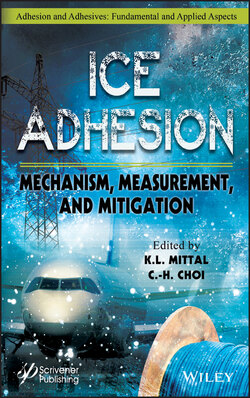Читать книгу Ice Adhesion - Группа авторов - Страница 13
1.1.2 Man is Carved of Ice
ОглавлениеIt is evident from Figure 1.1 that life and ice on Earth have had a symbiotic relationship. The emergence of new life on the planet has contributed to changes in the atmosphere, lessening the greenhouse effect, and leading to periods of glaciation (including the very first appearance of ice on the planet). The evolutionary selection pressures of drops in global temperature led to mass extinction events where the only organisms that survived were those fit to live in the cold. The cold climate selection pressures, among many others, led to the evolutionary emergence of more complex Eukaryotic cells, and eventually multicellular organisms which in death sequestered CO2, leading to more glaciation. This cycle continued with the introduction of land plants and animals, Dinosaurs, mammals, birds and flowers, until the current geologic period of the Earth - the Quaternary -was reached.
Figure 1.1 A geologic timeline of the Earth shows the symbiotic relationship between life and ice on the planet. The inset of the past 9 million years shows the specific relationship between glaciation of Earth (through oxygen-18 isotope measurements) and human evolution. δ18O data is taken from [22]. bya and mya denote billons of years ago and millions of years ago, respectively.
Climate fluctuations continue to affect the evolution of living things; the evolution of living things continues to affect the climate. In fact, the climatic conditions in the Quaternary Ice Age, including those which present the conditions for ice formation, have shaped the selection pressures experienced by early humans, and thus human evolution [23]. Although the first Primates evolved approximately 60 million years ago, the earliest Apes appeared on Earth approximately 20 million years ago [24]. As Earth entered the Neogenic and Quaternary periods, the characteristic dramatic climatic fluctuations of these geological time periods ushered in the evolution of the first Homininae, the tribe including Gorillas, Chimpanzees and Humans [25]. Earth’s climate throughout the Pliocene (beginning approximately 5.3 million years ago), Pleistocene (beginning 2.5 million years ago), and Holocene (beginning 12000 years ago) epochs has trended towards not only a colder more glaciated world, but also increased amplitude and frequency between cool and warm periods, as determined through oxygen isotope analysis of ice core samples [22]. Many of the major developments in hominin evolution have been coincident with the intensification of Northern Hemisphere glaciation, as shown in Figure 1.1 [26].
Adaptations to the increasingly unpredictable and unstable environments of the late Neogene and Quaternary periods might in fact be part of what it means to become a human in the Darwinian sense [26, 27]. The morphological and behavioural traits of terrestriality, bipedalism, dietary flexibility, tool use, omnivory, large brains, long-distance migrations, and the birth of dependant children, thought to characterize Homo sapiens have all been linked to fluctuations in Earth’s climate [23]. The environmental selection pressures led to evolutionary bottlenecks that, evidently, only our ancestors were able to pass through. Tool use and increased brain size specifically have been linked to periods of glaciation. The earliest evidence for the use of stone tools has been found in the Ethiopian region of Gona, where artifacts have been dated to 2.6 million years ago [28]. The first known use of tools coincides with the onset of Northern Hemisphere Glaciation 2.7-2.5 million years ago [29, 30]. As resources became scarce with falling temperatures, only those early human ancestors capable of constructing and utilizing tools for increased efficiency survived. Dramatic increase in the size and complexity of the brains of human ancestors, a process known as encephalization, also began around 2.6 million years ago. The average brain size increased from 600 mL to about 1 L. It is hypothesized that the cooler climate during the Northern Hemisphere Glaciation allowed for time hypermorphosis (or prolongation of the growth period), leading to the increased brain mass [31].
Evolution of Homininae continued through the first appearance of a species in the Homo genus: Homo habilis just over 2 million years ago, Homo erectus around 2 million years ago, and Homo ergaster around 1.9 million years ago [32]. Homo erectus persisted as a species for more than a million years until diverging gradually into new species including Homo neanderthalsis in Eurasia around 400,000 years ago, and the anatomically modern human being, Homo sapiens, in Africa between 300,000 and 200,000 years ago [33, 34]. Most of the past 350,000 years in East Africa have been a period of strong climatic oscillation, meaning that Homo sapiens with the capacity to create new and diverse tools, wide social networks, and the ability to plan are evolutionarily adept to diverse survival challenges [19, 23]. Homo sapiens dispersed from Africa in multiple waves, with the first anatomically modern humans reaching Mediterranean Europe between 45,000 and 43,000 years ago [35]. Humans and Neanderthals would go on to co-inhabit Eurasia for 2,000-6,000 years until the climate drastically changed once more towards a period of glaciation [33]. Once again the conditions which allow for the appearance of surface ice on Earth shaped the evolution of the genus Homo, creating a scarcity in resources for both Homo sapiens and Homo neanderthalsis. Neanderthals seem to have died out in Europe about 39,000 years ago. Whereas Humans employed large social networks comprised of oral and non-oral communication to collect and share materials, Neanderthals lived in a much smaller world, collecting raw materials exclusively from their local area [36]. This final evolutionary bottleneck is one of the key reasons for Homo sapiens survival while our evolutionary cousins did not.
